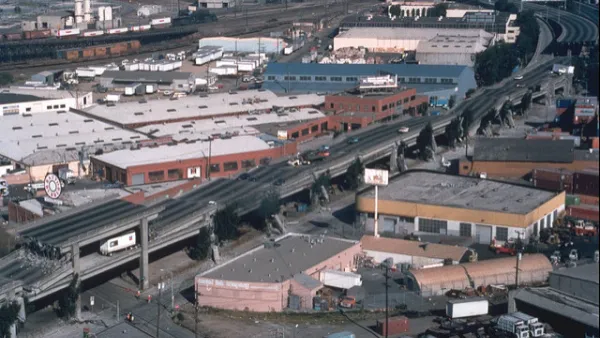Sunday's powerful Bay Area earthquake brought attention to the urgent need to retrofit existing buildings in California. One expert stated the damage in Napa "was predictable." Do you know the three types of construction that need to be reinforced?
"Experts have long known that three types of construction common in the state don't hold up well in quakes: brick or stone, those with "soft" stories—floors not well-reinforced—and certain kinds of concrete structures. In California, new construction of such buildings has been banned," writes Alejandro Lazo.
But such buildings haven't disappeared, and efforts to retrofit those remaining aren't uniform. The state leaves enforcement of such measures in the hands of local jurisdictions.
Lazo describes the retrofit required for each type of aforementioned construction. Napa had passed a 2006 ordinance requiring retrofit of unreinforced masonry. All but about six of these types of buildings had undergone retrofit when the quake hit.
Building damage was widespread nevertheless. "On Monday (August 25), the city of Napa said that 64 buildings had been tagged 'red' by inspectors as unsafe to enter. More than 100 were tagged 'yellow, meaning they require further inspection," notes Lazo.
Lucile Jones, a seismologist with the U.S. Geological Survey, who has been hired by the city of Los Angeles to evaluate its buildings, said the structural damage from Sunday's quake "was extremely predictable." Dr. Jones, who advises the state commission on risk reduction, added: "We now have to make a choice to do something about it before the next earthquake hits."
Correspondent's note on access to Wall Street Journal article: Subscriber-only content will be available to non-subscribers for up to seven days after August 26.
FULL STORY: Quake Raises Building-Safety Questions

National Parks Layoffs Will Cause Communities to Lose Billions
Thousands of essential park workers were laid off this week, just before the busy spring break season.

Retro-silient?: America’s First “Eco-burb,” The Woodlands Turns 50
A master-planned community north of Houston offers lessons on green infrastructure and resilient design, but falls short of its founder’s lofty affordability and walkability goals.

Delivering for America Plan Will Downgrade Mail Service in at Least 49.5 Percent of Zip Codes
Republican and Democrat lawmakers criticize the plan for its disproportionate negative impact on rural communities.

Test News Post 1
This is a summary

Test News Headline 46
Test for the image on the front page.

Balancing Bombs and Butterflies: How the National Guard Protects a Rare Species
The National Guard at Fort Indiantown Gap uses GIS technology and land management strategies to balance military training with conservation efforts, ensuring the survival of the rare eastern regal fritillary butterfly.
Urban Design for Planners 1: Software Tools
This six-course series explores essential urban design concepts using open source software and equips planners with the tools they need to participate fully in the urban design process.
Planning for Universal Design
Learn the tools for implementing Universal Design in planning regulations.
EMC Planning Group, Inc.
Planetizen
Planetizen
Mpact (formerly Rail~Volution)
Great Falls Development Authority, Inc.
HUDs Office of Policy Development and Research
NYU Wagner Graduate School of Public Service





























